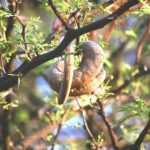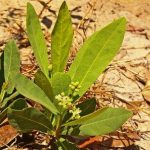TREE LIFE
June 2000
SUBS ($120) WERE DUE ON 1ST April. PLEASE USE THE INVOKE ATTACHED TO THE April ISSUE OF TREE LIFE IF YOU HAVEN’T ALREADY PAID.
WHILE THE PRESENT PROBLEMS PERSIST PLEASE CHECK WITH ANY OF THE COMMITTEE MEMBERS TO ENSURE THAT THE SCHEDULED OUTINGS AND WALKS WILL ACTUALLY TAKE PLACE.
MASHONALAND CALENDAR
Saturday 3 June. Botanic Garden Walk at 10.45 for 11 a.m. Tom continues with the very interesting topic ‘rarely seen trees’. We will meet Tom in the car park where there will be a guard for the cars.
Sunday 18 June. The outing scheduled for this month is cancelled.
Saturday 24 June. Mark’s walk this month has been cancelled.
Friday 23 – Sunday 25 June. The Succulent Expo 2000 scheduled to take place at the National Botanical Garden, has been cancelled.
Saturday 1 July. Botanic Garden Walk.
MATABELELAND CALENDAR
Sunday 4 June. To Hillside dams. Meet as usual in the car park at Girls’ College at 8.15 for 8.30 a.m. sharp. Please phone one of the committee members for confirmation of this meeting.
BOTANIC GARDEN WALK: TUESDAY 4TH APRIL 2000
The subject for today was Rutaceae, the Citrus family. The Botanic Garden is a wonderful source of living reference material and although not every Zim¬babwean member of the family is to be found there, most are and we were able to survey the whole family in about an hour.
As far as Zimbabwean species are concerned, the family has the following characteristics:
• mostly trees or shrubs (one perennial herb: Thamnosma rhodesica)
• with or without spines or prickles
• no stipules
• leaves usually alternate (but some opposite)
• leaves simple, 3-foliolate, digitate or imparipinnate (this feature provides a very useful and easy character)
• leaves dotted with pellucid glands
• leaves usually aromatic when crushed (because of the glands)
• inflorescence a panicle, raceme or cluster
• the flowers are unisexual or bisexual
• sepals, petals and stamens occur in multiples of 4 or 5
• the fruit may be a berry, drupe, capsule or follicle
The leaves provide an easy way to get a handle on the family. To start with the least degree of compoundness, four genera have representatives with simple leaves. These are the herbaceous Thamnosma referred to above, the genus Citrus, which although exotic, is a long-standing escape in certain places, Vepris drummondii (please see below) and Calodendrum.
Tom remarked that Calodendrum capense (the Cape chestnut) drops its leaves twice a year and may also flower twice a year. The flowers somewhat resemble a martagon lily and are slightly unusual in possessing sepals, petals and stamens and in addition a whorl of flattened staminodes which are longer than the petals and are dotted with crimson glands. The fruit is a large (c.3.5 cm in diameter), 5-lobed capsule, covered with warty projections. Calodendrum capense is basically a forest species, where it may attain 30 m in height.
On next to the genera with 3-foliolate leaflets. These are Teclea, Vepris, Toddalia, Toddaliopsis and Oricia.
Toddalia asiatica is a liana or scrambling shrub with numerous prominent prickles on the stems and leaves. It is a forest edge species, seen quite commonly in the eastern districts and also occurring on outliers such as Hwedza Mountain and Buchwa. The fruits resemble tiny lemons or naartjies.
The remaining 4 genera are broadly similar and it has been suggested that they should all be merged into the genus Vepris.
Of these, Oricia bachmannii (Twin-berry tree) may be recognised by its opposite leaves; the other genera in this group nearly always have alternate leaves. Tom mentioned also that its leaves are relatively large and that it has 4 free carpels, compared with united carpels in the others. The genus has 4 stamens and is therefore rather like Teclea.
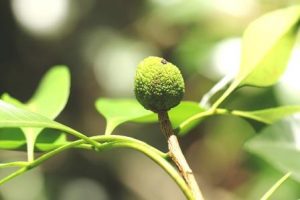
Toddaliopsis bremekampii . Photo: Bart Wursten. Source: Flora of Zimbabwe
Toddaliopsis bremekampii (the Wart-berry) is a rather rare species from the mist-belt in the SE of Zimbabwe. As the name suggests, it has a densely warty fruit. It also has 8 stamens.
The two remaining genera, Teclea and Vepris look very much alike and differ in technical characters. Teclea has c.4 stamens (Vepris c.8) and 1-seeded fruit (Vepris 4-seeded).
Five species of Teclea are known from Zimbabwe. We first looked at Teclea trichocarpa (the Furry-fruited Teclea). Tom mentioned that this occurs in the SE of Zimbabwe in places where there is extra moisture, for example the Nyoni Hills. The specimen in the Gardens was quite a large shrub. As the common name implies, it has velvety-hairy fruits.
Also discussed by Tom, but not seen, was Teclea fischeri, a compact shrub with small leaves, which occurs in the N of Zimbabwe. Later we looked at some specimens of Teclea rogersii, which is the shrubby species the Society revisited recently in the riverine vegetation by the Mazowe River at Christon Bank. Elsewhere it is typically riverine and at medium altitudes, occurring for example at the Victoria Fans.
Teclea nobilis (Small-fruited Teclea) is an understorey species of dry forest. It has quite large 3-foliolate leaves which have a leathery texture and is confined to the eastern districts. For completeness, one might also mention the only other Teclea in Zimbabwe, which is Teclea myrei (the Oval-fruited Teclea) which occurs in the SE of Zimbabwe.
On next to the closely-related genus Vepris. Vepris reflexa (Woodland Vepris) is a dioecious species with relatively large shiny leaves. Its distribution is scattered from the Matopos to the Limpopo escarpment and in the N of Zimbabwe – it is local and rarely seen.
Vepris zambesiaca (the so-called Rare woodland Vepris) is a hairy-leaved species with a winged petiole occurring typically as a small shrub around the base of mopane. It occurs sporadically at medium altitudes.
Tom mentioned only two Vepris spp., but I have one more, namely Vepris drummondii. According to Flora Zambesiaca, this has 1-foliolate leaves (i.e. it appears to be simple-leaved) and is an evergreen shrub collected from Mt Pene.
Next, the plants with pinnate leaves.
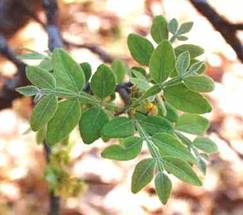
Citropsis daweana . Photo: Rob Burrett. Source: Flora of Zimbabwe
Citropsis daweana (the Wild citrus) is easily recognised by its leaves with a markedly winged rhachis. It is also armed with spines, has creamy or pale yellow flowers and spherical fruits. It occurs at lower altitudes mainly in the Zambezi Valley where it is to be found in Jesse or near Jesse or in riverine habitats.
Fagaropsis angolensis is one of the species with softly hairy opposite leaves. It is a forest edge species and also occurs in woodland in high rainfall areas – the Society quite often sees it in our trips to the Marondera and Hwedza areas.
Clausena anisata is a forest understorey and forest edge species of high rainfall areas, commonest in the eastern districts but also occurring on the outliers.
The genus Zanthoxylum was briefly touched upon. Tom showed us Zanthoxylum chalybeum (Kundanyoka knobwood) a fairly frequently-seen species in Mashonaland, occurring often on anthills.
Finally, to complete this survey of Zimbabwean Rutaceae, one might also mention two exotics. One is Casimiroa edulis (the Mexican apple), which is an exotic tree, commonly grown for its edible fruit and seen as an escape from time to time in higher rainfall areas. We have also seen a species of Murraya probably a relic of cultivation in riverine vegetation at Greystone Park Nature Reserve.
All in all, a very useful and interesting session in which I certainly learned a lot about the less well-known species in this family.
-Mark Hyde
CHABWENO FARM: 16 APRIL 2000
The Mashonaland Branch enjoyed a day’s outing to Chabweno Farm, on the Shamva Road in the beautiful Enterprise Valley, as the guests of Peter and Teig Howson. Fortunately the area was free from disturb¬ances that day, and over 20 members made the trip. It was a lovely sunny day, and the air sparkled in the aftermath of 30 mm of rain that had fallen the night before. It was the first Sunday outing for the members since February, as the March trip had been can¬celled because of the fuel shortage.
After meeting at the tobacco barns on the main road, we proceeded to the guest house and left half the vehicles there. A short walk in the vicinity of the dam gave us a taste of the sort of vegetation we were to encounter, and then we drove to the base of the rocky ridge that was our objective for the morning. The road crossed the causeway below the wall, and the cars appeared to plunge into a metre of water as they dipped below the level of the dam, giving rise to anxious comments from passengers. We drove past fields of yellow-flowering Sun Hemp, a species of Crotalaria once widely used as a green manure crop before the days of chemical fertilizers and now coming back into its own in organic farming systems. We left the cars in the woodland at the foot of the ridge and walked, slowly of course, up to the top, along the new road that had just been completed for our benefit, led by the ever-knowledgeable Phil Haxen, back from Queensland.
The dominant tree in the area is Julbernardia globiflora, the Mnondo, which is very distinctive at this time of the year with its crown of brown pods displayed above the foliage. In the same family there were some fine specimens of Brachystegia glaucescens, the ineptly named mountain acacia, on the ridge. Other trees that stood out on the hillside were Hymenodictyon floribundum, the fire bush, rather small but with striking orange to red leaves, and Sterculia quinqueloba with its fat trunk and smooth silver to pink bark. Patches of autumn coloured foliage were provided by some small specimens of Kirkia acuminata and Commiphora mossambicensis; the latter has distinctly peppery-scented leaves, in contrast to the very similar Commiphora mollis.
Several species of trees were easily recognized by their prominent pods. Pterocarpus angolensis showed off its hairy fried eggs, Combretum molle and Combretum zeyheri distinct four-winged fruit, and Terminalia sericea and
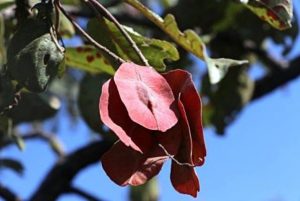
Terminalia stenostachya . Photo: Mark Hyde. Source: Flora of Zimbabwe
Terminalia stenostachya flat, winged pods. The fruit of Combretum zeyheri are much larger than those of the other members of the genus, while Terminalia sericea has as its diagnostic feature peeling bark on the smaller branchlets.
We compared the leaves of Cussonia arborea and Vitex payos. Although the growth habits of the two species are so different, they both have large compound leaves with five leaflets spreading fanlike from the end of the petiole. Vitex payos, the chocolate berry, was in fruit, and the relative flavours of the fruit and Charhons chocolate were discussed by the more knowledgeable members of the party.
A feature of the ridge that we climbed was the large flat granite domes interspersed with cracks in which a variety of plants were found. Water trickled over the rock in some places. We could not agree on the name of the species of Xerophyta that was present, although its fibrous stems and tufted leaves were distinctive. Euphorbia griseola ssp. mashonica shared the habitat with Euphorbia matabelensis. It is difficult to understand how taxonomists can put these plants into the same genus; Euphorbia griseola is a typical succulent with thin spiny branches, while Euphorbia matabelensis is a conventional tree, easily recognized by its three-fold branching zigzag habit and milky latex. Also present were specimens of Tapiphyllum velutinum, which we had last seen on the Great Dyke in February and which has distinctive crumpled velvety leaves; the velvety effect is produced by a thick cover of hairs that helps to reduce water loss when humidity is low. Elephantorrhiza goetzei with its compound feathery leaves, grew as a fringe at the foot of the rocky outcrops.
The view over the farmland from the top of the ridge was magnificent, and we came across some large specimens of Ficus glumosa along a stream running down from the hills beyond the ridge. We were puzzled for a moment by another thorn-less Acacia-like tree coppicing from a stump near the top, and finally recognized it as Albizia tanganyicensis. It could have been cut because it can be poisonous to livestock, although later Teig told us that the tree was a victim of firewood gatherers.
On the way down to the cars we detoured into an outcrop large of large granite boulders to view a small gallery of rock paintings in a crevice guarded by some large Bequaertiodendron magalismontanum, the stem fruit, which I always recognise by its leathery, strap-like discolourous leaves.
Back at the guest house we enjoyed our picnic lunch in the garden. Many of the party hurried back to town to watch cricket on their TVs. A few snoozed in their deck chairs, “had a little read”, and the hard core wandered down to the river below the house, where I must admit the botanising was desultory.
Our warm thanks to the Howsons for allowing us to visit their guest house, complete with security guards, as a car park and a lunch site, and to Teig in particular for guiding us on our walk.
-John Lawrence
Continuing ‘In Retrospect’ Msasa ‘bleeding’
In Tree Life No. 3 a question was asked about the cause of red gum from three Msasa trees in a garden in Chinhoyi. A dead branch had been cut off one of the ‘bleeding’ trees and this was found to be full of ‘worms’, and the question was asked whether these ‘worms’ were connected with the ‘bleeding’ of red gum.
The answer was supplied in Tree Life No. 5 through information from Dr. Phelps of the Zoology Dept at UZ. Longicorn beetles (family Cerambycidae) are just one of the species of beetles that infest Msasa trees. They are distinguished by very long antennae, sometimes longer than the beetle’s body. The adult deposit eggs in the bark of the tree, and the larvae burrow inwards feeding on the tree’s tissue. However, another beetle of the family Buprestidae, is a far more common parasite, and is probably responsible for most of the ‘bleeding’ we see.
It is a small, slightly iridescent beetle with short antennae. Here again it is the larvae that bore into the wood; these are comma-shaped, with large head and curved body.
Some ‘bleeding’ is undoubtedly caused by the feeding of these larvae, but the more profuse exudation of gum is often the result of a bacterial or viral infection that begins at the entry point of the boring larva. Whether the larva or the adult actually carries the infection to the tree is uncertain, but thought likely.
Combretum for breakfast contribution from Tree Life No. 7 (0ctober 1980).
In a note in the South African journal The Ostrich Peter Steyn describes how he saw the southern black tit, Parus niger, holding down on to a branch winged fruits of the velvet-leaved Combretum, Combretum molle, with both feet, pecking at them. He refers to another description by C. Schoute-Vanneck in the Natal Bird Club News Sheet, which supplies detailed information. He collected fruits from the ground, and in 85% of those that had been pierced by the bird were silken threads and larvae droppings, indicating that they had been infested by a parasite. He subsequently collected fruits from this tree, and found that they contained fat white larvae about 5 mm long, later identified as the larvae of Chalcid wasps of the family Eurytomidae.
The southern black tit (Roberts 527) is a bird with a wide distribution, said to “inhabit thick bush, mopane forest, and even quite scrubby woodland, where it hunts about from ground level to the tree tops in search of food. Nests are built at the bottom of holes in hollow trees or tree stumps”.
[Comment 2000: in a more modern edition of Roberts (5th Edition, 1985) the number of the southern black tit has been changed to 554, and the habitat is described as “almost any woodland, gardens, dense thornveld, edges of evergreen, exotic plantations.]
The Importance of Recording Observations
A note by GH in Tree Life No. 7 (October 1980).
Object (E) of the Tree Society is “to collect and encourage collection of all forms of information relating to trees, and to publish it by all available means”.
We are currently inviting members to so contribute their observations for publication. Some, I feel, think their contributions are of little interest, and I would like to quote an extract from that famous naturalist/diarist, Gilbert White of Selborne, who recorded in 1788.
“One of my neighbours shot a ring dove on an evening as it was returning from feed and going to roost. When his wife had picked and drawn it she found the cr stuffed with the most nice and tender turnip tops. These she washed and boiled and so sat down to a choice and delicate plate of greens culled and provided in this extraordinary manner. Hence we may see that granivorous birds when grain fails, can subsist on the leaves of vegetables.”
White’s contemporaries may well have been excused for saying he was wasting his time, and I dread to think what his ecclesiastical superior’s opinion of his natural history writings must have been. But apart from the great pleasure his book has given to countless readers since then, the above quotation, with the facts it recorded, was of great value to a scientific/agricultural study on the habits of the pigeons two centuries later.
[Comment 2000: Gilbert White (1720-1793) was an English clergyman and naturalist noted for his The Natural History of Selborne, which was first published in 1789. By 1988 no less than 90 additional editions had been published – the work of different editors, and produced in different languages, including Danish, English, German, Japanese (3 editions) and Swedish. A search through the 1988 edition, edited by Richard Mabey, failed to turn up White’s observation quoted above, which is hardly surprising because the last of White’s letters included in this edition was dated June 25, 1787.]
-Lyn Mullin ‘In Retrospect’ will be continued.
A SHANGAAN AND HIS TREES – FROM HARTEBEEST No. 6 1974 (CONTINUED)
Julias Manavele, son of Manavele, is a Shangaan of the lowveld and was born about fifty-five years ago on the banks of the Makari River on Triangle, where he is now attendant in charge of the High Syringa Game Park.
This list is the contribution from Tree Life No. 243 of the uses to which trees are put, as described by Julias to Colin Saunders.
Euclea divinorum: no common name: Hlangula.
Water with crushed leaves is used to bath children as it brings out the rash in measles.
Garcinia livingstonei: no common name: Himbi.
Sticks are used to stir porridge. Fruits are eaten.
Flacourtia indica: no common name: Tuza.
Wood is a second-class spoon material. Fruits are eaten.
Coffea racemosa: wild coffee: Pela.
Fruits are eaten.
Combretum apiculatum: rooibos: Chikukutsi.
Poles are used for making huts.
Combretum hereroense: no common name: Potsa.
Wood used for making axe and badza handles.
Combretum imberbe: leadwood: Monzo.
Poles used for making huts and for pounding grain. Ash used to make whitewash for huts.
Combretum mossambicense: no common name: Grawusika.
Flowers are eaten raw and are very sweet.
Balanites aegyptiaca: torchwood: Nulu
Crushed roots are thrown into water to chase fish into traps.
Dombeya rotundifolia: wild pear: Muluwati
Branches used to manufacture bows.
Gardenia ternifolia: wild gardenia: Chitsala
The wood is incandescent and is a favourite for fires – good light, hot, keeps burning.
Acacia nigrescens: knob-thorn: Mukaya
Planks are cut from the trunk and used for doors. Also good for axe handles.
Acacia tortilis: umbrella thorn: Sesani
Fibres are stripped from branches and used in binding poles in hut building.
Berchemia discolor: bird plum: Nyiyi
Fruits are eaten. Dry bark is taken off, pounded until soft, water added, then Ilala palm shoots and the mixture is boiled for 3-4 hours. This makes a red paint.
Hyphaene natalensis: Ilala palm: Ihanga
A tree of many uses: hats, baskets, sieves and water pots are made from fronds, which are also used for thatching. Ilala ‘‘wine’’ bled from the living tree, beer (huchema) from the fermenting fruits, which are also eaten raw. Top part of stem cooked and eaten, tastes like pumpkin. Dishes (huhlelo) also made from these trees, as are drums (ngoma).
Borassus aethiopum: Borassus palm: Brumo
Fruits are opened when they fall, either eaten raw, or boiled with water to make porridge.
Phoenix reclinata: date palm: Ichindu
Fruits eaten, as is top part of stem, which is very sweet; leaves used to make baskets, mats, dishes, and as thatching. Beer is made from fermented fruits.
Androstachys johnsonii: ironwood: Simbiri
Poles are used in building huts. Their sticks for whips and fishing rods.
Artabotrys brachypetalus: no common name: Titi
Fruits are eaten.
Cassia abbreviata: long-tailed cassia: Lumanyama
Bark is removed and pounded, put in containers, water is added, and the concoction drunk to cure venereal disease. Note how many trees of this species are severely scarred as a result.
Senna petersiana: dwarf cassia: Nembenembe
Roots are boiled with water, and liquid used to treat diarrhoea in children.
Commiphora mollis: cork-wood: Kuhunu
Wood used for manufacture of plates, and also for Shangaan piano (timbila). Superficial bark is removed, dried in the sun, worked until soft, applied to burns and then left until burns have healed. Fruit is inedible.
Dichrostachys cinerea: Chinese lantern: Tsenge (pl. mitsenge)
Seedpods collected for stock-food.
Dalbergia melanoxylon: no common name: Chilutsu
Tobacco containers and walking sticks made from wood.
Crossopteryx febrifuga: no common name: Kombegwa
The best material for spoon manufacture. Bark boiled and liquid drunk to relieve abdominal pain.
THE LEMON-SCENTED BARK OF HILLSIDE PARK
As soon as the commonage had passed into the hands of the Council, a number of plots on the flat area in the west, called Belvedere, bordered by the Marimba, a strongly flowing stream, had been surveyed. There was a keen demand by would-be leaseholders for the plots. Those on the river were used for growing vegetables, those which were larger, and further away, were kept for grazing. The lessees put up grass shelters for their cattle, planted gum trees for shade, and sank wells… The success of this venture led to plots on the Makabusi being surveyed in Hillside…
GH TANSER (1974) – A SEQUENCE OF TIME
It was on 4 February 1901 that the, then, Salisbury Town Council was granted 20 000 acres (8 000 hectares) of Commonage by the British South Africa administration, and the planting of eucalypts would have been done in the rainy season of 1901-02 and 1902-03. Some of the former commonage on either side of the Mukuvisi (Makabusi) river is today’s Hillside Park, located between the suburbs of Hillside and Braeside, and bounded east and west by Glenara Avenue South and Chiremba (Widdecombe) Road. It was brought into Harare’s parks system in the 1950s.
Near the pedestrian gate into Hillside Park, at the intersection of Brooks Drive and Yates Road, there are three specimens of lemon-scented gum, Eucalyptus citriodora. Two of these trees are unremarkable, but the third is probably the largest of its kind in Harare, and the tallest in the whole of Zimbabwe. In October 1986, when it was aged 84-85 years, it was 50 m tall, with a diameter of 1.14 m and a clear bole of 17 metres.
There are two other noteworthy lemon-scented gums in Zimbabwe. One stands at the intersection of Prince Edward Street and Josiah Chinamano Avenue in Harare. This is a large, open-crowned tree in the southwest corner of a plot first registered in the name of WT Biddulph, who first took possession on 29 September 1900. The tree was probably planted in the rainy season of 1900-01, and it is remembered for its impressive size in the mid-1920s by Prince Edward schoolboys of that time, who saw it from across the street. In October 1986 it had a height of 31.5 m, a trunk diameter of 1.02 m and a crown spread of 25 metres.
The second of the two is at Mount Selinda Mission at Chirinda Forest. When the missionaries began planting exotic trees is not known, but eucalypts must have featured at an early stage, for some very large ones stand in the mission grounds today. One of these is a short-boled, heavily branched lemon-scented gum showing in the open about 300 m to the south of the old mission sawmill. In December 1986 it had a bole diameter of 1.52 m, a rather modest height of only 33 m, and a crown diameter of 36 metres. It is certainly not the best-formed lemon-scented gum in the country, but it has the largest bole diameter of any of its kind.
Lemon-scented gum is a native of Queensland in Australia, where it occasionally reaches a height of 50 m and a diameter of 1.2 m, so our tree in Hillside Park is up with the best natural specimens. It is easily recognized by its powdery white, sometimes pinkish, bark and the strong lemon scent of the crushed leaves, a scent that is retained even in the dry, fallen leaves at the base of the tree. The wood is hard and heavy, of good quality, and its resilience makes it especially useful for tool handles. It belongs to Eucalyptus subgenus Corymbia, which some Australian botanists have elevated to the rank of genus. This move, however, is rejected by many other Australian botanists.
-Lyn Mullin
ANDY MACNAUGHTAN CHAIRMAN


